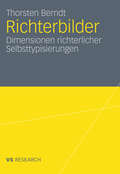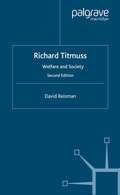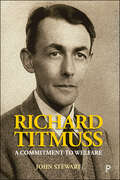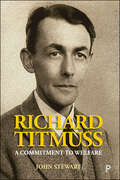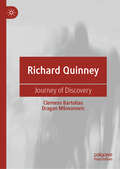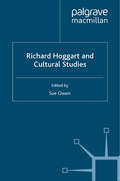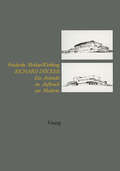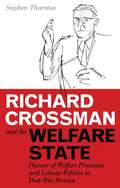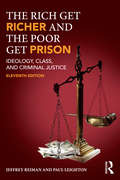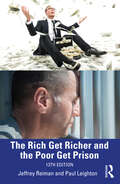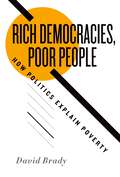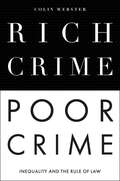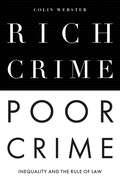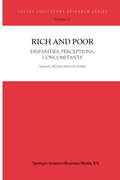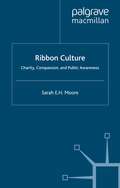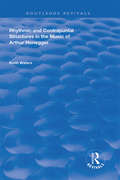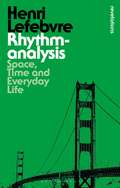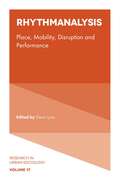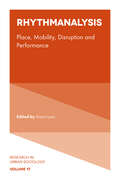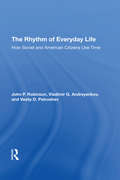- Table View
- List View
Richterbilder: Dimensionen richterlicher Selbsttypisierungen
by Thorsten BerndtSozialwissenschaftliche Forschung, die ihre Aufgabe darin sieht, die Fragen der Welt in der Welt zu betrachten und aus einer Perspektive des lebensweltlichen Bezugs dann ihre eigenen Fragen zu stellen und zu beantworten sucht, bedarf einer Nähe zum Feld, die ein beidseitiges persönliches Vertrauen von Forscher und Beforschten voraussetzt. Als ein solcher Forscher verstanden, trete ich mit der Bitte um Vertrauen an die jeweiligen Personen. Für diese Untersuchung waren es die vielen Richterinnen und Richter, bei denen ich mich an dieser Stelle zuerst – wenn auch in der gebotenen unpersönlichen Anonymität – für ihre Offenheit und das entgegengebrachte Vertrauen bedanken möchte. Akademische Ausbildung, die ihre Aufgabe darin sieht, Menschen zu - fähigen, selbständig wissenschaftlich zu arbeiten, hat durch die Abnahme von Qualifikationsprüfungen ein »Nadelöhr« geschaffen, durch das der Promovend – mithilfe entsprechend legitimierter »Geburtshelfer« – hindurchmuss. Für die hier vorliegende Dissertation, die im Jahr 2009 am Fachbereich Geschichte und Soz- logie der Universität Konstanz angenommen wurde, freue ich mich, als Gutachter und Betreuer Hans-Georg Soeffner sowie Martin Morlok nennen zu können, die mich auf dem langjährigen Weg unterstützt und gefördert haben. Zu diesem Weg gehört eine Geschichte mit mehr oder weniger zuträglichen Begleitern und - ständen. Ich möchte mich mit meinem Dank auf die positiven Aspekte der hilfr- chen Unterstützung dieses Weges beziehen: Ausgangspunkt liegt bei den für diese Arbeit ursächlichen Projektzus- menhängen der Jahre 2000 bis 2004 an der FernUniversität in Hagen und an der Universität Düsseldorf unter der Leitung von Martin Morlok.
Richard Titmuss; Welfare and Society: Welfare and Society
by D. ReismanRichard Titmuss, Professor at the London School of Economics, adviser to governments, prolific author, was instrumental in shaping the new disciplines of Social Policy and Administration. He made a valuable contribution to social philosophy through his attempt to integrate welfare into its broad social context. In this revised edition of his well-known book, Professor Reisman relies on the whole of Titmuss's work, unpublished as well as published, to explain and evaluate the theories of this provocative but often difficult author.
Richard Titmuss: A Commitment to Welfare
by John StewartThis is the first full-length biography of Richard Titmuss, a pioneer of social policy research and an influential figure in Britain’s post-war welfare debates. Drawing on his own papers, publications, and interviews with those who knew him, the book discusses Titmuss’s ideas, particularly those around the principles of altruism and social solidarity, as well as his role in policy and academic networks at home and overseas. It is an enlightening portrait of a man who deepened our understanding of social problems as well as the policies that respond most effectively to them.
Richard Titmuss: A Commitment to Welfare
by John StewartThis is the first full-length biography of Richard Titmuss, a pioneer of social policy research and an influential figure in Britain’s post-war welfare debates. Drawing on his own papers, publications, and interviews with those who knew him, the book discusses Titmuss’s ideas, particularly those around the principles of altruism and social solidarity, as well as his role in policy and academic networks at home and overseas. It is an enlightening portrait of a man who deepened our understanding of social problems as well as the policies that respond most effectively to them.
Richard Quinney: Journey of Discovery (Palgrave Pioneers in Criminology)
by Clemens Bartollas Dragan MilovanovicThis book traces the life course of Richard Quinney, one of the most cited authors in the social sciences and a key figure in the development of critical criminology in the 70s, 80s and 90s. It provides a look into his personal thoughts in becoming a 'radical' criminologist and situates it in his various experiences, questioning, and shifts in his journey through life. Richard has contributed to a profound paradigm shift in criminology, beginning with his book, The Social Reality of Crime (1970), but also to peacemaking criminology as well as peace studies. He has also written several books via an autoethnography approach and has presented a number of photograph presentations for which he has received awards. It traces his early development on the family farm in Wisconsin to his travels in higher academe. It gives a personal perspective in becoming not only a radical criminologist, an accomplished writer in auto-ethnography, visual sociology, and photography but also how his continuous questioning of the meaning of it all came to fruition with profound insights about what it is to be human. The book will be inspirational to not only seasoned veterans in criminology, but also to emerging scholars, to undergrads and grads, showing them the struggles that come in 'making it'.
Richard Hoggart and Cultural Studies
by S. OwenIn this new collection of essays, a range of established and emerging cultural critics re-evaluate Richard Hoggart's contribution to the history of ideas and to the discipline of Cultural Studies. They examine Hoggart's legacy, identifying his widespread influence, tracing continuities and complexities, and affirming his importance.
Richard Crossman and the Welfare State: Pioneer of Welfare Provision and Labour Politics in Post-war Britain (International Library of Political Studies)
by Stephen ThorntonGenerally remembered as a notorious diarist rather than a serious political figure, Richard Crossman's six years as minister during the 1964-1970 Labour governments proved, not least to himself, a disappointment. While his imposing presence in Harold Wilson's Cabinet brought radical proposals including the wholesale reform of Parliament, the absence of any substantial legislative legacy have let Crossman's political actions fade undeservedly into obscurity. However, in this new assessment of Richard Crossman, Stephen Thornton argues that Crossman's commitment to welfare reform makes him of the most important figures in the postwar history of the British welfare state.From 1955 to the end of his life in 1974, Crossman was committed to a radical scheme that promised to break Britain free from the existing Beveridge model of welfare provision. This scheme involved relating contributions and benefits to earnings, and would have transformed the social security regime in the UK. That the central pillar of Crossman's project, an earnings-related pension scheme designed for all, failed to be implemented during his period in government partly explains the common perception of his political failure. Yet, as this book explains, despite this particular defeat, Crossman's story should not be ignored. Crossman's actions did prompt modifications to both Labour and, more surprisingly, Conservative social security policy, and these changes were to prove highly significant. Moreover, the defeat of Crossman's pension scheme is, in itself, an interesting tale. Crossman himself considered it, 'a story rich in lessons'. Here Stephen Thornton rehabilitates Crossman's reputation as a towering figure of the patrician Left. He argues that more than a figure of enduring interest, Crossman's project of welfare reform remains valid and in the era of New Labour the lessons Crossman learned are more valuable and relevant than ever.
The Rich Get Richer and the Poor Get Prison: Ideology, Class, and Criminal Justice
by Jeffrey Reiman Paul LeightonFor nearly 40 years, this classic text has taken the issue of economic inequality seriously and asked: Why are our prisons filled with the poor? Why aren’t the tools of the criminal justice system being used to protect Americans from predatory business practices and to punish well-off people who cause widespread harm? The Rich Get Richer shows readers that much that goes on in the criminal justice system violates citizens’ sense of basic fairness. It presents extensive evidence from mainstream data that the criminal justice system does not function in the way it says it does nor in the way that readers believe it should. The authors develop a theoretical perspective from which readers might understand these failures and evaluate them morally—and they to do it in a short and relatively inexpensive text written in plain language. New to this edition: Presents recent data comparing the harms due to criminal activity with the harms of dangerous—but not criminal—corporate actions Presents new data on recent crime rate declines, which are paired with data on how public safety is not prioritized by the U.S. government Updates statistics on crime, victimization, wealth and discrimination, plus coverage of the increasing role of criminal justice fines and fees in generating revenue for government Updates on the costs to society of white-collar crime Updates and deepened analysis of why fundamental reforms are not undertaken Streamlined and condensed prose for greater clarity
The Rich Get Richer and the Poor Get Prison: Ideology, Class, and Criminal Justice
by Jeffrey Reiman Paul LeightonFor nearly 40 years, this classic text has taken the issue of economic inequality seriously and asked: Why are our prisons filled with the poor? Why aren’t the tools of the criminal justice system being used to protect Americans from predatory business practices and to punish well-off people who cause widespread harm? The Rich Get Richer shows readers that much that goes on in the criminal justice system violates citizens’ sense of basic fairness. It presents extensive evidence from mainstream data that the criminal justice system does not function in the way it says it does nor in the way that readers believe it should. The authors develop a theoretical perspective from which readers might understand these failures and evaluate them morally—and they to do it in a short and relatively inexpensive text written in plain language. New to this edition: Presents recent data comparing the harms due to criminal activity with the harms of dangerous—but not criminal—corporate actions Presents new data on recent crime rate declines, which are paired with data on how public safety is not prioritized by the U.S. government Updates statistics on crime, victimization, wealth and discrimination, plus coverage of the increasing role of criminal justice fines and fees in generating revenue for government Updates on the costs to society of white-collar crime Updates and deepened analysis of why fundamental reforms are not undertaken Streamlined and condensed prose for greater clarity
The Rich Get Richer and the Poor Get Prison: Thinking Critically About Class and Criminal Justice
by Jeffrey Reiman Paul LeightonFor 40 years, this classic text has taken the issue of economic inequality seriously and asked: Why are our prisons filled with the poor? Why aren’t the tools of the criminal justice system being used to protect Americans from predatory business practices and to punish well-off people who cause widespread harm?This new edition continues to engage readers in important exercises of critical thinking: Why has the U.S. relied so heavily on tough crime policies despite evidence of their limited effectiveness, and how much of the decline in crime rates can be attributed to them? Why does the U.S. have such a high crime rate compared to other developed nations, and what could we do about it? Are the morally blameworthy harms of the rich and poor equally translated into criminal laws that protect the public from harms on the streets and harms from the suites? How much class bias is present in the criminal justice system—both when the rich and poor engage in the same act, and when the rich use their leadership of corporations to perpetrate mass victimization?The Rich Get Richer, the Poor Get Prison shows readers that much of what goes on in the criminal justice system violates citizens’ sense of basic fairness. It presents extensive evidence from mainstream data that the criminal justice system does not function in the way it says it does nor in the way that readers believe it should. The authors develop a theoretical perspective from which readers might understand these failures and evaluate them morally—and they do it in a short text written in plain language.Readers who are not convinced about the larger theoretical perspective will still have engaged in extensive critical thinking to identify their own taken-for-granted assumptions about crime and criminal justice, as well as uncover the effects of power on social practices. This engagement helps readers develop their own worldview.New to this edition: Presents recent data comparing the harms due to criminal activity with the harms of dangerous—but not criminal—corporate actions Updates research on class discrimination at every stage of the criminal justice system Updates statistics on crime, victimization, incarceration, and wealth Increased material for thinking critically about criminal justice and criminology New material on global warming and why Black Lives Matter protests did not cause increases in crime in 2020 Expanded discussion of marijuana and drug legalization Stronger chapter overviews, clearer chapter structure and expanded review questions Streamlined and condensed prose for greater clarity
The Rich Get Richer and the Poor Get Prison: Thinking Critically About Class and Criminal Justice
by Jeffrey Reiman Paul LeightonFor 40 years, this classic text has taken the issue of economic inequality seriously and asked: Why are our prisons filled with the poor? Why aren’t the tools of the criminal justice system being used to protect Americans from predatory business practices and to punish well-off people who cause widespread harm?This new edition continues to engage readers in important exercises of critical thinking: Why has the U.S. relied so heavily on tough crime policies despite evidence of their limited effectiveness, and how much of the decline in crime rates can be attributed to them? Why does the U.S. have such a high crime rate compared to other developed nations, and what could we do about it? Are the morally blameworthy harms of the rich and poor equally translated into criminal laws that protect the public from harms on the streets and harms from the suites? How much class bias is present in the criminal justice system—both when the rich and poor engage in the same act, and when the rich use their leadership of corporations to perpetrate mass victimization?The Rich Get Richer, the Poor Get Prison shows readers that much of what goes on in the criminal justice system violates citizens’ sense of basic fairness. It presents extensive evidence from mainstream data that the criminal justice system does not function in the way it says it does nor in the way that readers believe it should. The authors develop a theoretical perspective from which readers might understand these failures and evaluate them morally—and they do it in a short text written in plain language.Readers who are not convinced about the larger theoretical perspective will still have engaged in extensive critical thinking to identify their own taken-for-granted assumptions about crime and criminal justice, as well as uncover the effects of power on social practices. This engagement helps readers develop their own worldview.New to this edition: Presents recent data comparing the harms due to criminal activity with the harms of dangerous—but not criminal—corporate actions Updates research on class discrimination at every stage of the criminal justice system Updates statistics on crime, victimization, incarceration, and wealth Increased material for thinking critically about criminal justice and criminology New material on global warming and why Black Lives Matter protests did not cause increases in crime in 2020 Expanded discussion of marijuana and drug legalization Stronger chapter overviews, clearer chapter structure and expanded review questions Streamlined and condensed prose for greater clarity
Rich Democracies, Poor People: How Politics Explain Poverty
by David BradyPoverty is not simply the result of an individual's characteristics, behaviors or abilities. Rather, as David Brady demonstrates, poverty is the result of politics. In Rich Democracies, Poor People, Brady investigates why poverty is so entrenched in some affluent democracies whereas it is a solvable problem in others. Drawing on over thirty years of data from eighteen countries, Brady argues that cross-national and historical variations in poverty are principally driven by differences in the generosity of the welfare state. An explicit challenge to mainstream views of poverty as an inescapable outcome of individual failings or a society's labor markets and demography, this book offers institutionalized power relations theory as an alternative explanation.
Rich Democracies, Poor People: How Politics Explain Poverty
by David BradyPoverty is not simply the result of an individual's characteristics, behaviors or abilities. Rather, as David Brady demonstrates, poverty is the result of politics. In Rich Democracies, Poor People, Brady investigates why poverty is so entrenched in some affluent democracies whereas it is a solvable problem in others. Drawing on over thirty years of data from eighteen countries, Brady argues that cross-national and historical variations in poverty are principally driven by differences in the generosity of the welfare state. An explicit challenge to mainstream views of poverty as an inescapable outcome of individual failings or a society's labor markets and demography, this book offers institutionalized power relations theory as an alternative explanation.
Rich Crime, Poor Crime: Inequality and the Rule of Law
by Colin WebsterIn 21st century Britain the rich are protected while the poor punished. Rich Crime, Poor Crime shows how contemporary British society is founded on a legacy of past plunder and dispossession by elites against the rest. Over centuries, power and property have been consolidated in the hands of a few and coded in legal systems that favoured the rich and created extreme inequality. Colin Webster puts a spotlight on Britain’s hereditary and new ruling classes, whose inherited entanglements in land ownership, war and conquest, new world slavery, finance, trade, industry and empire allow them to accumulate and grow capital and wealth at the expense of others. He reveals a system facilitated by political corruption and wealth that accommodates serious wrongdoing – such as corporate, banking and accounting fraud, money laundering and tax evasion – and does substantial harm to fellow Britons. Examining the conditions of extreme inequality that give rise to poor crime and rich crime – and to the social response to both types of crime – we find them to be deeply implicated one with the other. Rich Crime, Poor Crime is vital reading for academics and professionals interested in the fields of history, sociology, criminology, and politics.
Rich Crime, Poor Crime: Inequality and the Rule of Law
by Colin WebsterIn 21st century Britain the rich are protected while the poor punished. Rich Crime, Poor Crime shows how contemporary British society is founded on a legacy of past plunder and dispossession by elites against the rest. Over centuries, power and property have been consolidated in the hands of a few and coded in legal systems that favoured the rich and created extreme inequality. Colin Webster puts a spotlight on Britain’s hereditary and new ruling classes, whose inherited entanglements in land ownership, war and conquest, new world slavery, finance, trade, industry and empire allow them to accumulate and grow capital and wealth at the expense of others. He reveals a system facilitated by political corruption and wealth that accommodates serious wrongdoing – such as corporate, banking and accounting fraud, money laundering and tax evasion – and does substantial harm to fellow Britons. Examining the conditions of extreme inequality that give rise to poor crime and rich crime – and to the social response to both types of crime – we find them to be deeply implicated one with the other. Rich Crime, Poor Crime is vital reading for academics and professionals interested in the fields of history, sociology, criminology, and politics.
Rich and Poor: Disparities, Perceptions, Concomitants (Social Indicators Research Series #15)
by Wolfgang GlatzerThis book is concerned with the question of inequality - which points to a major structural problem in intra-national and inter-national respect. It covers the tension between the rich and poor in less developed countries as well as within richer countries in the process of globalisation. The main topics are the scope of disparities between the rich and poor, people's perception of wealth and poverty, and the concomitants of inequality which shape this relationship and influence its socio-economic consequences. In the tradition of social reporting, the book brings together authors from 15 countries, documenting a broad range of the international inequality debate. The results are related to the trends of socio-economic development, to statistical problems of measuring inequality, and to socio-political problems of integrating society in the facing the challenge of dividing forces. The book is of interest for everybody who wants to understand the tensions of modern world.
Ribbon Culture: Charity, Compassion and Public Awareness
by Sarah E.H. MooreThis book explores the history, meaning, and sociological implications of awareness campaigns, seeing them as personal displays of compassion in a culture where empathy is a by-word for authenticity. It also highlights how charities use awareness campaigns to reach their audience, and the transformation of charity into a commercial enterprise.
Rhythmic and Contrapuntal Structures in the Music of Arthur Honegger
by Keith WatersThis title was first published in 2002. Through analyses of a number of Honegger's compositions, including extended analyses of two of Honegger's orchestral works, "Mouvement symphonique No. 2 (Rugby)" and "Symphonie pour cordes", Keith Waters examines the principles of musical organization in Honegger's music and shows how these principles are based on systematic rhythmic and contrapuntal strategies. Musical form in Honegger's work, the book argues, is articulated by contrapuntal and rhythmic structures rather than by tonal structure, and it is this that provides the source of compositional unity in Honegger's music.
Rhythmic and Contrapuntal Structures in the Music of Arthur Honegger
by Keith WatersThis title was first published in 2002. Through analyses of a number of Honegger's compositions, including extended analyses of two of Honegger's orchestral works, "Mouvement symphonique No. 2 (Rugby)" and "Symphonie pour cordes", Keith Waters examines the principles of musical organization in Honegger's music and shows how these principles are based on systematic rhythmic and contrapuntal strategies. Musical form in Honegger's work, the book argues, is articulated by contrapuntal and rhythmic structures rather than by tonal structure, and it is this that provides the source of compositional unity in Honegger's music.
Rhythmanalysis: Space, Time and Everyday Life (Bloomsbury Revelations)
by Henri LefebvreRhythmanalysis displays all the characteristics which made Lefebvre one of the most important Marxist thinkers of the twentieth century. In the analysis of rhythms -- both biological and social -- Lefebvre shows the interrelation of space and time in the understanding of everyday life.With dazzling skills, Lefebvre moves between discussions of music, the commodity, measurement, the media and the city. In doing so he shows how a non-linear conception of time and history balanced his famous rethinking of the question of space. This volume also includes his earlier essays on "The Rhythmanalysis Project" and "Attempt at the Rhythmanalysis of Mediterranean Towns."
Rhythmanalysis: Space, Time and Everyday Life (Bloomsbury Revelations)
by Henri Lefebvre Gerald Moore Stuart EldenRhythmanalysis displays all the characteristics which made Lefebvre one of the most important Marxist thinkers of the twentieth century. In the analysis of rhythms -- both biological and social -- Lefebvre shows the interrelation of space and time in the understanding of everyday life.With dazzling skills, Lefebvre moves between discussions of music, the commodity, measurement, the media and the city. In doing so he shows how a non-linear conception of time and history balanced his famous rethinking of the question of space. This volume also includes his earlier essays on "The Rhythmanalysis Project" and "Attempt at the Rhythmanalysis of Mediterranean Towns."
Rhythmanalysis: Place, Mobility, Disruption and Performance (Research in Urban Sociology #17)
by Dawn LyonThis collection brings together new and original research on the concept and practice of ‘rhythmanalysis’ in urban sociology as a means to analyse the relationship between the time and space of the city. Originally proposed by French philosopher and urban scholar, Henri Lefebvre and his collaborator, Catherine Régulier, in the twentieth century, ‘rhythmanalysis’ continues to capture the attention of urban scholars today. Including in-depth analyses of the rhythms of place-making, this volume takes us from the City of London to the Caminito of Buenos Aires. Exploring the production of rhythm on the move – in cars and on the street - in relation to urban atmospheres and the implications of mobility for climate emergency, the chapters consider what happens when everyday urban rhythms are disrupted and reconfigured. Delving into the mobilisation of the body, materials and technologies to make and detect rhythm, this collection sparks new interest in using rhythmanalysis as a mode of sensing and making sense of the complex entanglements of time and space at the heart of everyday urban life. It is an appealing read for scholars and students in urban sociology, social and cultural geography, mobilities studies, and the sociology and philosophy of time.
Rhythmanalysis: Place, Mobility, Disruption and Performance (Research in Urban Sociology #17)
by Dawn LyonThis collection brings together new and original research on the concept and practice of ‘rhythmanalysis’ in urban sociology as a means to analyse the relationship between the time and space of the city. Originally proposed by French philosopher and urban scholar, Henri Lefebvre and his collaborator, Catherine Régulier, in the twentieth century, ‘rhythmanalysis’ continues to capture the attention of urban scholars today. Including in-depth analyses of the rhythms of place-making, this volume takes us from the City of London to the Caminito of Buenos Aires. Exploring the production of rhythm on the move – in cars and on the street - in relation to urban atmospheres and the implications of mobility for climate emergency, the chapters consider what happens when everyday urban rhythms are disrupted and reconfigured. Delving into the mobilisation of the body, materials and technologies to make and detect rhythm, this collection sparks new interest in using rhythmanalysis as a mode of sensing and making sense of the complex entanglements of time and space at the heart of everyday urban life. It is an appealing read for scholars and students in urban sociology, social and cultural geography, mobilities studies, and the sociology and philosophy of time.
The Rhythm Of Everyday Life: How Soviet And American Citizens Use Time
by John RobinsonThis book describes an important advance in international social science research—the first cooperative survey of representative samples of the United States and the Union of Soviet Socialist Republics. It identifies changes in the time-use patterns of both cities during the last two decades.
